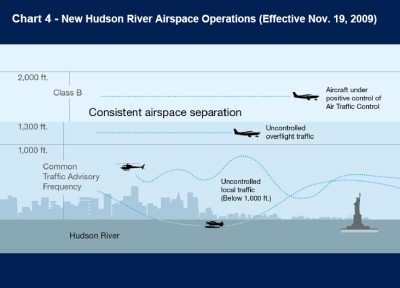Mon, Nov 16, 2009
Modifications Designed To Enhance Safety
 The FAA has finalized a federal rule, effective November 19,
2009, that will enhance safety by separating low-altitude, local
aircraft flights over the Hudson River from flights transiting
through the river airspace. "Better separation of aircraft
means a higher margin of safety," said U.S. Transportation
Secretary Ray LaHood. "These new rules will ensure that aircraft
can operate safely in the busy Hudson River airspace."
The FAA has finalized a federal rule, effective November 19,
2009, that will enhance safety by separating low-altitude, local
aircraft flights over the Hudson River from flights transiting
through the river airspace. "Better separation of aircraft
means a higher margin of safety," said U.S. Transportation
Secretary Ray LaHood. "These new rules will ensure that aircraft
can operate safely in the busy Hudson River airspace."
"These changes will define separate corridors for aircraft
operating locally and those flying along the Hudson River area,"
said FAA Administrator Randy Babbitt. "Separating aircraft on
different missions and improving pilot situational awareness will
add more layers of safety to this high-demand airspace."
The rule also now requires pilots to follow safety procedures
that were previously recommended, but were not mandatory. In a new
Special Flight Rules Area over the Hudson and East Rivers, pilots
must:
- Maintain a speed of 140 knots or less.
- Turn on anti-collision and aircraft position/navigation lights,
if equipped.
- Self-announce their position on specific radio
frequencies.
- Carry current charts for the airspace and be familiar with
them.

In an exclusion zone below 1,300 feet over the Hudson River,
pilots must announce their aircraft type, position, direction and
altitude at charted mandatory reporting points and must stay along
the New Jersey shoreline when southbound and along the Manhattan
shoreline when northbound.
Pilots transiting the Hudson River must fly at an altitude
between 1,000 feet and 1,300 feet. Local flights will operate in
the lower airspace below 1,000 feet.
The rule also will incorporate provisions of an October 2006
NOTAM that restricted fixed-wing aircraft in the exclusion zone
over the East River to seaplanes landing or taking off on the river
or those specifically approved by FAA air traffic control.
All three updated pilot charts that local fixed wing and
helicopter pilots use for navigation will include these airspace
changes on November 19, 2009. The FAA will conduct seminars
and coordinate with pilot groups to make pilots aware of the new
requirements. The FAA also has developed an online training program
that covers flight operations in the New York area.
More News
19-Year-Old Pilot Was Attempting to Fly Solo to All Seven Continents On his journey to become the first pilot to land solo on all seven continents, 19-year-old Ethan Guo has hit a >[...]
From 2017 (YouTube Edition): A Quality LSA For Well Under $100k… Aeroprakt unveiled its new LSA at the Deland Sport Aviation Showcase in November. Dennis Long, U.S. Importer>[...]
Hazardous Weather Information Summary of significant meteorological information (SIGMET/WS), convective significant meteorological information (convective SIGMET/WST), urgent pilot>[...]
Aero Linx: Historic Aircraft Association (HAA) The Historic Aircraft Association (HAA) was founded in 1979 with the aim of furthering the safe flying of historic aircraft in the UK>[...]
"We would like to remember Liam not just for the way he left this world, but for how he lived in it... Liam was fearless, not necessarily because he wasn't afraid but because he re>[...]
 TikToker Arrested After Landing His C182 in Antarctica
TikToker Arrested After Landing His C182 in Antarctica Classic Aero-TV: Versatile AND Practical - The All-Seeing Aeroprakt A-22 LSA
Classic Aero-TV: Versatile AND Practical - The All-Seeing Aeroprakt A-22 LSA ANN's Daily Aero-Term (06.27.25): Hazardous Weather Information
ANN's Daily Aero-Term (06.27.25): Hazardous Weather Information ANN's Daily Aero-Linx (06.27.25)
ANN's Daily Aero-Linx (06.27.25) Aero-News: Quote of the Day (06.27.25)
Aero-News: Quote of the Day (06.27.25)




